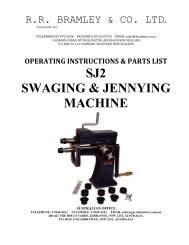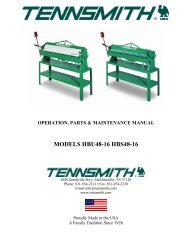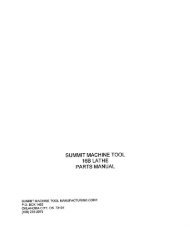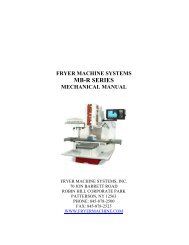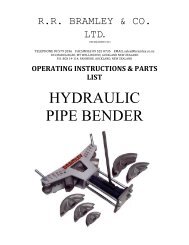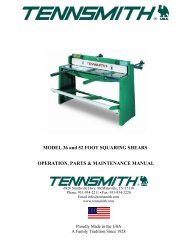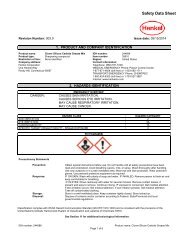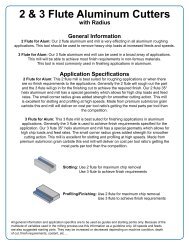You also want an ePaper? Increase the reach of your titles
YUMPU automatically turns print PDFs into web optimized ePapers that Google loves.
See the contents page for the blade guideprint.The distance the linkage assembly travelsfrom the back of the blade to the meteringvalve, to close the valve and stop saw headfeed, must be .030 to .040.More than .040 linkage travel will not controlthe sawing force and could allow saw teeth toenter between the rollers, ruining the bladeand rollers.Less than .030 linkage travel holds themetering valve partly closed and holds thesaw head in suspension, or feed down onlyslowly.If the sawing force check failed, item 6, theabove produces other than the dialed sawingforce.See the guide arm print 446805.a. Make a quick, visual, linkage travelcheck, about 1/32 inch.Start the saw head feeding down slowly. Usea screwdriver to pry the linkage assembly upfrom the blade guide casting, forcing themetering valve closed as if the blade wereforcing the linkage to close the meteringvalve.b. If prying up on the linkage with thescrewdriver stops the saw head, inspect thecarbide blade backup slipper.Resurface or replace a slipper with a bladetrack worn to .030.See spare parts.c. If the screwdriver test stops the sawhead with a new or replaced backup slipper,linkage travel is out of adjustment.Take a positive reading.Fasten a dial indicator to the right guide armwith the contact point on the back edge of theblade under the metering valve. Set the dialto "0."d. Place a block of wood under the blade atthe indicator location.Bring the saw head down with the tensionedblade coming to rest on the block of wood.Read the dial indicator when the saw headstops.e. If the linkage traveled more than .040 itis too short to close the metering valve.Raise the saw head and see the blade guideprint.Locate the threaded stud, with a dowel hole,inside the spring under the metering valveadjusting spool.Slip a dowel into the hole to hold thethreaded stud while loosening the hex locknut under the dowel.Use the dowel to turn the threaded studcounterclockwise, up out of the connectingrod, to lengthen the metering valve linkage:½ turn of the threaded stud = .035 inch.If linkage traveled less than .030 it is toolong. Turn the threaded stud clockwise toshorten the stem.Repeat the linkage travel test with the dialindicator.With linkage travel from the blade to themetering valve properly adjusted within .030to .040, if the screwdriver and sawing forcetests still fail go on to the next item for ametering valve inspection.9. Metering valve check.See the contents page for the blade guideand metering valve prints.With each blade change, inspect the bladeguides for chips and sludge build up. Theyprevent the metering valve and linkage fromworking properly. If the sawing force checkfailed check the blade guides and linkagebefore making this check.Particles flaking from walls of hydraulic linesaccumulate in the sawing force system.Check the change date on the hydraulic fluidfilter cartridge.a. Lower the saw head and lock or tag outthe electric disconnect.NOTE: If the saw head will not come downbecause of a clogged metering valve, blockup under the guide beam to prevent the sawhead dropping during the next step.b. Disassemble and clean the valve body.Remove socket head screws holding thevalve to the valve body.c. Pull plungers and seals from inside thevalve body. Wash all parts in mineral spirits.Inspect the seals for embedded particles.Replace them from 2,000 hour spare parts ifnecessary.d. Cleaning and replacing worn parts fromthe blade guide rollers and backup slippers,up to the metering valve, is a completesawing force system overhaul.Properly accomplished, this brings aboutproper results with the sawing force check,item 6.16



